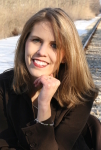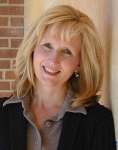|
Susan Meissner interview with Cara Putman
|
|
January 19, 2009
Harvest House was looking for a series from me, and I knew the only kind I could feel good about writing was the kind where there’s closure at the end of each book. Mysteries are great for that because a good one offers a great solution at the end. Even if the recurring characters have some issues that they take with them into the next book, the overall tone of the book is one of closure. I picked the legal genre in particular because I had just spent a couple years as a guardian ad litem for the State of Minnesota. A guardian ad litem is a court-appointed advocate for children involved in child protection and truancy cases. I spent a lot of time with kids, parents, social workers, attorneys and in courtrooms during those two years so I felt like I had the basic knowledge to tell an accurate story. 2) What was the greatest challenge for you in writing a legal series? The greatest challenge was getting all the little details to ring true. You can’t just make stuff up when you’re writing about police procedure and legal proceedings. Every time I had a character in a courtroom, in a police station, at the attorney’s office, I had to double check every action to make sure it could actually happen that way. For example, in one of my books, I had a person confess to a murder. A confession alone is not enough to seal a guilty verdict. The evidence must bear that the confessor actually did it. So when my character confessed to killing someone, I still had to take that person through the court process. He didn’t go from confessing in a police station to a prison cell. 3) How did you conduct research to get the details right? When I began the Rachael Flynn series and gave my lead character a position with the prosecutor’s office for Ramsey County in St. Paul, I knew I had to talk to someone who knew what that job would entail. My experience was only with county attorneys in a district courthouse in a rural community. I knew it was going to be different in the big city. I called the Ramsey County Attorney’s office and asked if there was anyone, anyone at all, who could spend 10, 20, or 30 minutes with me so that I could pepper them with questions. To my utter joy, a managing prosecutor who dabbled in writing himself offered to do just that. We talked for 45 minutes. When we were done, he asked me if I had to head out right away (I had 100-mile commute home). I said no. He said, “Do you want to go court?” I said, “You bet I do!” He took me to the felony courtroom for the afternoon docket. I got to sit in the front row with the other prosecuting attorneys. It was the perfect way to envision my own character coming into that room from the jail and answering the charges against him. I also sent many scenes to a lawyer friend of mine who works for a public defender’s office in Florida. Between the two attorneys, I had two knowledgeable resources for getting the details right. 4) Rachel Flynn has a slightly supernatural element to the plot, yet it works. How did you balance her foresight/dreams so that the plot isn’t conveniently resolved by that element? I wanted there to be something unique about Rachael Flynn, otherwise she wouldn’t be different than any other determined young woman in every other legal mystery. Giving her insights that come from God allowed me to make the faith element organic. I didn’t have to force theological issues or concepts into the dialogue and narrative. Those elements came naturally because Rachael was dealing with an obvious gifting by God on a slightly supernatural level. 5) You’ve written about ten books. How do you find a fresh angle for each? It’s actually getting harder, not easier to write new material. That surprised me about writing. Each time I finish a book I raise the bar for myself. Each subsequent book has to have an angle I haven’t touched before and that gets harder! Part of landing on new material is being uber observant. I try to take everything in. I read newspapers and news magazines to stay on top of cultural and societal changes – these often suggest a new premise for a novel. Once I have a new premise in mind I ask myself why it matters. When I know that, then I know what angle to take. Without it, I’ve nothing but an idea. 6) If you could write any book you wanted and know it would land on the bestsellers list, what would you write? I guess I am really hoping The Shape of Mercy goes to that special place called the bestseller’s list. That book means a lot to me personally. I think there is so much to be learned from the times in our history when we’ve let snap judgments rule our thinking. If we loved more and judged less we’d find ourselves on a different kind of planet. It would still be flawed, and so would we, but it would be different. We’d be different. 7) The Shape of Mercy is your latest release and a beautiful story of three women from different times and generations. How did you come up with the germ of an idea and then weave their stories together? I read an article a couple of years ago about a woman petitioning a Massachusetts court to exonerate her great-times-eight grandmother who was accused and convicted of witchcraft during the witch trials, was released when the hysteria ended, but whose name was never cleared. Reading the article brought back memories of reading The Crucible in high school and being in a play called “To Burn A Witch” when I was in junior high. The men and women hung in Salem in 1692 were all later declared innocent. They died proclaiming devotion to God and refusing to confess to an allegiance with Satan, even though a confession would have kept them from execution. That is remarkable to me. And there was a story there to be told. Heroism is always story-worthy. 8) What did you learn from Rachel and Mercy as you wrote their stories? I saw myself often in Lauren as she transcribed Mercy’s diary and she came to realize how much she truly didn’t want to judge people but she did. She just did. We all do. We see a homeless man begging on the streets and we make all kinds of assumptions about how he got there and what he would do if we reached out to help him. We see a pregnant teenager or an obese child or a woman wearing diamonds and Jimmy Choos and we assume the teenager has no morals, the child has no restraint and the woman is wealthy and therefore has no worries. We believe these things because group-think tells us it’s so. Jumping to conclusions seems to permeate culture, regardless of the generation. Whatever the crowd says, we too easily believe. My lawyer character Rachael ran into the same problem with bias because she dealt with people accused of crimes, or suspected of crimes, often because of stereotyping. We assume too much, too often. 9) You’re a big proponent of pre-writing. What is it and why do you think it’s so helpful for writers? Pre-writing is like packing your car for a long trip. You check all the belts and fluids, you put air in the tires, you pack a suitcase, you take some food that travels well, you pinpoint good places to stop for rest along the way and you bring a map with you of where your destination is so you can get there. Pre-writing is envisioning your story before you write it. It’s getting to know your characters on an intimate level before you write a word of story, it’s mapping your plot, figuring our your key transitions, researching your setting, your character’s jobs, their homes, their schools, their personas, before you write. It’s packing your car for a long trip. I didn’t start out to be a writer who pre-writes. In the beginning of my career as a novelist, I really wasn’t aware that I was one. I wrote my first novel in 10 weeks, my second in eight, and my fifth was written in 30 days. People were asking me right and left how in the world did I write so fast. I needed a better answer than, “That’s just how the stories come out of me.” So I studied how I wrote and I realized how much upfront work I did before writing one word of actual story. And I learned that pre-writing – planning, plotting and preparing – allowed me to write at an accelerated pace. Not only that, but I didn’t hit walls, I didn’t have multiple drafts – just one – and I didn’t have boatloads of edits to do when the manuscript was complete. 10) When someone approaches you wanting to learn more about writing, what do you recommend they do if they seriously want to pursue the dream of seeing a book in print? If publication is your goal, there are two things you must do. 1. Write an irresistible book, and 2. Put yourself in places where you can meet editors and agents so that you can show them your irresistible book. For the latter, that’s easy. You need to invest in attending a writer’s conference that’s nationally known and brings in the editors from publishing houses you want to publish for. That’s the place to meet editors and agents face to face. The former is hard, hard, hard. You must be writing all the time, reading all the time, growing in your skills as a writer, writing all the time, subjecting yourself to critique, responding positively to it, honing your craft, listening to experts, and writing all the time. The more you write, the better you become at it. The more you learn from other writers, the better you become at it. I actually suggest this aspiring writer start with an easy goal: “I want to learn more about writing!” Save the goal of, “I want to be published!” for after she or he has mastered some easier ones. |
Warning: getimagesize(https://www.thesuspensezone.com/image/caraputman150.jpg): failed to open stream: HTTP request failed! HTTP/1.1 406 Not Acceptable
in /home/susans16/thesuspensezone.com/xxss_class/Utils.class.php on line 849
Warning: Division by zero in /home/susans16/thesuspensezone.com/xxss_class/Utils.class.php on line 856

 SUSAN MEISSNER is an award-winning newspaper columnist, a pastor’s wife, and the author of numerous novels, including A Seahorse in the Thames, In All Deep Places, and A Window to the World (named one of the Top Ten Christian Novels of 2005 by Booklist magazine), as well as the three installments of the Rachael Flynn Mystery series. A mother of four, she lives in southwestern California with her husband, Bob.
SUSAN MEISSNER is an award-winning newspaper columnist, a pastor’s wife, and the author of numerous novels, including A Seahorse in the Thames, In All Deep Places, and A Window to the World (named one of the Top Ten Christian Novels of 2005 by Booklist magazine), as well as the three installments of the Rachael Flynn Mystery series. A mother of four, she lives in southwestern California with her husband, Bob.





Leave a Reply